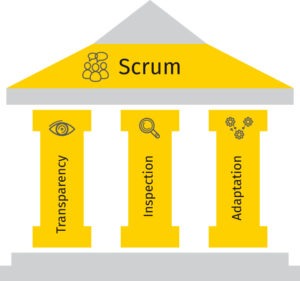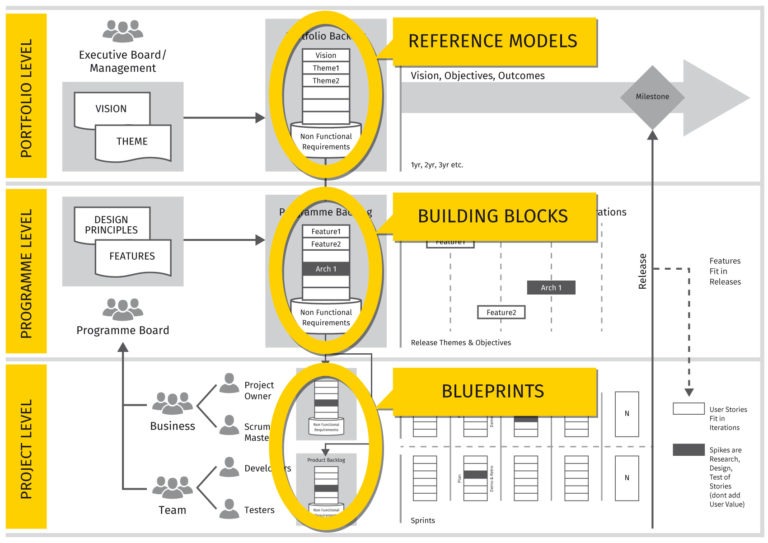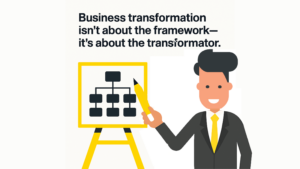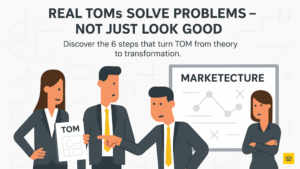Brexit is a hot topic right now, half the country (or those that voted) are keen to leave, the other half want to stay.
With the new PM in post since 24th July, and even more determined to get either a deal or no deal over the line on 31st October, one thing is for sure, if you are in business, have a business or lead a business that has dealings outside of the UK, and particularly the EU you need a plan.
Below are the three (3) priorities to focus in the event of a no deal outcome:
- Architecture,
- Strategy, and
- Governance
In this post, we will discuss the three (3) priorities to focus on in the event of a no deal. The priorities are intentional, and sequential as they build on each other.
Architecture
The first area of focus is Architecture, and we’re not talking buildings, we’re talking Enterprise – specifically Business Architecture, and its counterpart Technology Architecture.
As an Organisation, agile or otherwise, in order to be able to respond to changes in the market quickly, which ever that maybe (i.e. the unknown of Brexit – deal, or no deal), you need to know which levers to push, which you can push and whether they are prepared to be pushed and give the required result.
Those levers are in your architecture.
You need both a broad understanding of your Business Architecture and its role and link to your IT architecture that the Organisation needs to meet the ever changing demands of the customer across the whole organisation, and across the full end-to-end Customer journey(s) your Customers have with your Organisation.
From there, you need to take that broad knowledge and be able to dive deep in specific areas, understand what is working well and what is candidate(s) for change.
You do this by understanding the business capability, complexity, cost, risk and maturity assessment of the current state architecture to meet ongoing and current business outcome and simplification goals.
For an organisation to be agile, operations need to be simplified.
We live in a state of information (and data) and process overload. Complexity is the enemy. Simplicity is the key.
We live in a state of information (and data) and process overload. Complexity is the enemy. Simplicity is the key.
Heath Gascoigne Tweet
Organisations that are able to cut process, and time out of their operations will improve their ability to change as quick as the market does.
Organisations that are able to cut process, and time out of their operations will improve their ability to change as quick as the market does.
Heath Gascoigne Tweet
You need to create simple and agile architectures that drive clear business value and re-across the Organisation and in doing so, remove cost and most importantly as Organisations implement the ‘digital’ aspects of their business transformation, to remove legacy process and systems from the landscape creating the foundations for your agile organisation.
As part of the current state architecture assessment, the next step is to develop and maintaining realisable capability based roadmaps spanning a 5-year horizon.
In a business-capability driven approach, these are your levers.
Using your Business Architect and Business Architecture in this business-led approach, with your 5-year business capability road maps, highlighting the people, process and technology changes, impact and costs assessments, you will have the ammunition to fully support your business case development with signature ready packages that deliver timely, fit for purpose strategic transformations in business capability up to Director level.
Of course, you will need your Business Architects to maintain and communicate up-to-date knowledge of best practice and industry trends across Business Architecture and Business Transformation. Hold tight, I have a little plan for that for you. Keep reading.
Strategy
The next priority is Strategy. This priority like the next is actually a parallel activity with Architecture. As you build up the context of WHAT are the changes, WHERE are they, and HOW does the Organisation need to change, you need to make sure the WHY – the Business strategy, is joined up with the IT strategy.
As you are building up and developing the case for change with the Architecture above, your Business Architects role is (and has been) providing valuable (and often overlooked – see my previous post on why digital transformations fail here), input and support the creation of an IT strategy owned by your Technology Architect and Technology Architecture team.
Remember, Business Transformation is everyone’s business. Your Business Architect can’t do it alone, nor can your Technology Architect do it on their own. It’s a team effort.
Your Business Architect will gain traction for your Target Operating Model (TOM) by promoting, evangelising and agreeing the IT strategy and Business Architecture across all teams by building and ensuring there is consensus and understanding across the business and technology architecture, as well as most crucially, your Leadership and SMT.
How your Business Architect will do this is by collaborating and specifying the organisation’s vision, goals, opportunities and related activities in order to maximize the business benefits of Business Architecture initiatives to the Organisation. To develop a full and proper Enterprise Business Architecture, this needs to cover all lines of business and cover all key customer journeys.
To get everyone signing from the same hymn sheet, your Business Architect must ensure their peers and the Enterprise / Solution Architect community is fully aware of the latest IT strategy and Business / Enterprise Architecture guidance. You do this by setting up early your establishing your Design Principles, as part of your Governance Framework (to learn more about our Governance framework, visit here).
Ongoing, your Business Architect must work within your innovation community across the Organisation including market research, technical specialists, CIO, analysts and partners to develop an awareness of, and learn not just the Brexit implications as they evolve and finalise, but changing customer demands and needs as a result of Brexit and changes and advances in technology that result in the changing customer demands and needs.
Governance
So now you have the Architecture and Strategy priorities in hand and underway, you need Governance. Without control, you have chaos, but too much governance you stifle change. You need a balance.
To get this balance between creation and control, you need to first establish policies and principles.
In HOBA® – 6-step business transformation framework, it is aligned to industry standards, including TOGAF®, Zachman, Process Management and Architecture, and Agile (SAFe and Scrum).
In terms of Scrum, HOBA® follows the 3-Pillar principles of:
- Transparency – development and implementation of the Business Architecture is transparent and therefore visible and available to any interested parties;
- Inspection – the Reference Models, Building Blocks and Blueprints that make up the Business Architecture are inspected frequently so unexpected variances in the process (and output) can be detected; and
- Adaptation – the ‘inspector’ (your Business Architect in this case) can adjust the process and output as required to ensure alignment with the strategic objectives.

This ensures the Business Architecture, methods, standards and best practices are maintained, as there are always ‘eyes’ on it, with regular review and feedback, releasing latest and up to date versions of architecture Reference Models, Building Blocks and Blueprints in regular intervals (end of sprints) at regular cadence, that allows further work to continue.
In terms of SAFe, this means in terms of your Enterprise Architecture (i.e. both Technology Architecture, and Business Architecture), you need not only right people using the right method, but following the right process to get the right result.
You need the Vision that was agreed with the Leadership team and SMT (recommended by the analysis and proposals from your Architecture team), agreed and signed off, and cascaded down through the Portfolio level, to their respective Programmes and Projects to implement these strategic intents.

By following an agile approach, ensuring your specialist teams and SMEs are consulted, and releasing regular and up to date versions of architectures to the Business, you can be assured that both the Business and IT Architecture, methods, standards and best practices are maintained, but are remain compliant to Legal, Regulatory and Security requirements.
By having your governance in place, you will ensure your Business Architecture deliverables are fit for purpose and provide an effective and timely tool to guide downstream decisions on your IT Architecture (and not the other way around. I wrote about this in a previous post here).
And finally, with your Business Architecture, you will have supporting evidence, backed up by your Business (namely the technical specialists and SMEs consulted for their input into the 5-year roadmap, that supports the Vision), to review current and proposed budgets and project portfolio investment roadmaps to ensure alignment with Business and Enterprise Architectures and the fit-for-purpose of the IT strategy, understanding dependencies across the roadmaps, organisational capacity for change including resource constraints.
If you need help with these three (3) priorities, you can join the last 2-Day Agile Digital Transformation Masterclass we are running for 2019, no more until Q2 2020, where regardless of the Brexit outcome, you will be in a strong position to take advantage of the situation, as opposed to being a victim of it.
Details and early-bird tickets here:
Thank you for reading this!
Sincerely,
Heath Gascoigne
P.S. If you want to join our Business Transformator community of like-minded Business Transformators, join the community on the Business Transformator Facebook Group here.
P.P.S. If you want to learn more about business transformation, check out The Business Transformation Playbook here.
For more information, visit https://www.hoba.tech












